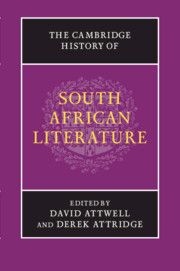Book contents
- Frontmatter
- Introduction
- PART I ORATURES, ORAL HISTORIES, ORIGINS
- PART II EXPLORATION, EARLY MODERNITY AND ENLIGHTENMENT AT THE CAPE, 1488–1820
- PART III EMPIRE, RESISTANCE AND NATIONAL BEGINNINGS, 1820–1910
- PART IV MODERNISM AND TRANSNATIONAL CULTURE, 1910–1948
- PART V APARTHEID AND ITS AFTERMATH, 1948 TO THE PRESENT
- PART VI SOUTH AFRICAN LITERATURE: CONTINUITIES AND CONTRASTS
- 33 South Africa in the global imaginary
- 34 Confession and autobiography
- 35 ‘A change of tongue’: questions of translation
- 36 Writing women
- 37 The experimental line in fiction
- 38 The book in South Africa
- 39 Literary and cultural criticism in South Africa
- Index
- References
33 - South Africa in the global imaginary
from PART VI - SOUTH AFRICAN LITERATURE: CONTINUITIES AND CONTRASTS
Published online by Cambridge University Press: 28 January 2012
- Frontmatter
- Introduction
- PART I ORATURES, ORAL HISTORIES, ORIGINS
- PART II EXPLORATION, EARLY MODERNITY AND ENLIGHTENMENT AT THE CAPE, 1488–1820
- PART III EMPIRE, RESISTANCE AND NATIONAL BEGINNINGS, 1820–1910
- PART IV MODERNISM AND TRANSNATIONAL CULTURE, 1910–1948
- PART V APARTHEID AND ITS AFTERMATH, 1948 TO THE PRESENT
- PART VI SOUTH AFRICAN LITERATURE: CONTINUITIES AND CONTRASTS
- 33 South Africa in the global imaginary
- 34 Confession and autobiography
- 35 ‘A change of tongue’: questions of translation
- 36 Writing women
- 37 The experimental line in fiction
- 38 The book in South Africa
- 39 Literary and cultural criticism in South Africa
- Index
- References
Summary
‘South Africa’ has long meant different things to different people. As a discursive construction, the term has traded on – and been influenced by – contending representations and performances across a range of media, the reception of which, both within the region and ‘abroad’, has necessarily had an effect on what this label is taken to name. Reception is always interested, influenced by ideological or psychological imperatives, whether by apologists for or subjects of empire, members of anti-colonial or anti-apartheid movements, exiles and émigrés, or by only apparently disinterested outsiders for whom the region's vicarious rewards have been – and are – many. Thus ‘South Africa’, once no more than a descriptive geographical term of convenience, has served for disaggregated global communities of interest variously to signify a site of adventure, sport or recuperation, a space marked by vitality or cruelty, reconciliation and redemption, and been mediated or contested as a kind of home. During the second Anglo-Boer or South African War, it named the location of one of imperial Britain's most serious moments of crisis, while simultaneously providing occasion for transnational identifications by such diverse groups as Irish nationalists and aristocratic tsarist Russians, who shared little with the proto-Afrikaner Boers besides opposition to the British Empire. For much of the second half of the twentieth century it served in a global imaginary largely as the domain of a white nationalist regime whose policies propelled the word ‘apartheid’ into the global lexicon.
- Type
- Chapter
- Information
- The Cambridge History of South African Literature , pp. 695 - 716Publisher: Cambridge University PressPrint publication year: 2012
References
- 4
- Cited by

